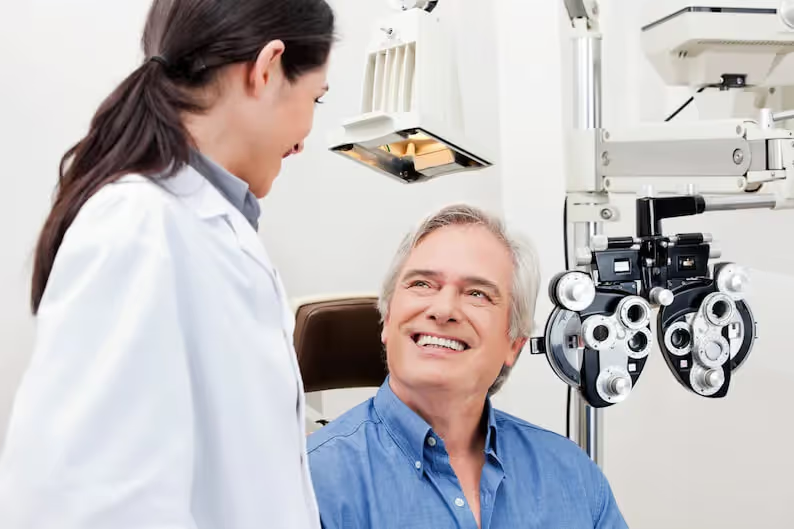Age-related macular degeneration (AMD) is the leading cause of vision loss and blindness for Americans aged 65 years and older. It occurs when there is damage to the macula – a small area at the back of the eye and retina. The macula is responsible for sharp, central vision. When there is damage, vision loss usually begins gradually, progressing to profound loss or graying of central vision. There are two main types of age-related degeneration, dry and wet. The wet form is more advanced and damaging, often leading to severe or permanent vision loss. Dry AMD is the most common, accounting for about 90 percent of cases. There's no cure for macular degeneration. Treatment merely consists of measures to delay the progression of the eye disease. Although there is no cure, there are healthy habits that help to prevent age-related macular degeneration. By making just a few small and simple changes in your life, you can help to reduce your risk of developing the onset of AMD.
Stop Smoking
If you only make one change, make quitting cigarettes, or any other type of smoking, be it! Smoking cessation is quite possibly the number one modifiable risk factor for people with AMD. No matter how long you've been a smoker, by putting the butt out, you drastically reduce your risk of AMD for each and every year you go without smoking. Smoking is the leading contributing factor to severe vision loss as a result of AMD. Studies have shown that smoking speeds up the progression of AMD by five times compared to non-smokers. In addition, the dangerous habit exposes you to free radicals that can damage your eye and keep nutrients and antioxidants from reaching it. You can't quit soon enough!
Maintain A Healthy Blood Pressure and Weight
Hypertension, or high blood pressure, causes narrowing of the blood vessels that nourish the eye. This restricts blood flow to the vascular layer of the eye, which in turn accelerates the progression of AMD. High blood pressure doubles your risk of developing wet AMD and suffering from central vision loss. Medication and moderate lifestyle changes can reduce and help maintain a healthy blood pressure. For example, staying at a healthy weight along with exercising and limiting your salt intake can all help to lower your blood pressure. Small gains can have a significant effect on your health and risk for AMD.
Eat More Antioxidants, Including Leafy Greens
By adding antioxidant-rich foods to your diet, you help provide your body with much-needed protection against free radicals and oxidative stress. These are the harmful cells that attack your healthy cells, which then lead to disease and destruction. When AMD is present, the retina becomes more susceptible to oxidative stress. In addition, individuals with AMD tend to experience an overall increase of oxidative stress throughout their bodies, making it much more difficult for the body to fend off damaged cells from the eye. Leafy greens, such as kale, spinach, Swiss chard, and collards, are chock-full of antioxidants that help to protect from cellular damage. Broccoli, carrots, and fruits, such as blueberries, are also excellent sources of antioxidants.
Take A Supplement
Although it's great to get as many vitamins and nutrients as you can from your diet, supplements can ensure you get your necessary daily requirements. Research conducted by the National Eye Institute (NEI) called the Age-Related Eye Disease Studies (AREDS) suggests that a special blend of vitamins may decrease your risk of developing advanced age-related macular degeneration. The special supplement known as AREDS, consists of nutrients, including beta-carotene, copper, vitamin C, vitamin E, and zinc. Even though research has shown these vitamins to be effective, you should never add supplements to your daily routine without consulting your physician first. Many medications and supplements can have adverse effects when combined and should always be monitored by a medical professional.
Wear Sunglasses
Probably the easiest healthy habit to prevent age-related macular degeneration is to wear eye protection when outside. Wearing sunglasses is important in protecting your eyes from harmful rays. Long-term exposure to ultraviolet (UV) light can cause damage to the retina, which only accelerates the progression of AMD. The American Macular Degeneration Foundation (AMDF) recommends that you wear sunglasses with a UV 400 rating. Ultraviolet rays are present on both sunny and overcast days, so it's important you have protection in both your sunglasses and clear lenses. The UV protection available is an invisible coating that doesn't change the color or appearance of the eyeglass lens.
Get Your Eyes Checked
Having regular eye examinations should be part of your normal health care routine. By having your eyes examined routinely, your healthcare provider can look for any signs or symptoms of age-related macular degeneration, along with any other eye diseases. Most eye specialists will utilize a test you can also use at home known as the Amsler grid to look for signs of AMD. For this test, you stare at a paper grid to check your central field of vision. This is also helpful in tracking the progression of AMD. Early diagnosis and treatment are vital in controlling the progression of age-related macular degeneration. While there's still a lot to learn and discover about AMD, what we do know is by adopting healthy habits, you can help to prevent age-related macular degeneration. Don't take a risk with your vision. Instead, make the lifestyle changes and utilize prevention. If you have concerns or questions regarding age-related macular degeneration, contact your healthcare provider or eye specialists today. Healthy vision must be actively pursued as you get older. Make your eyes a priority.




